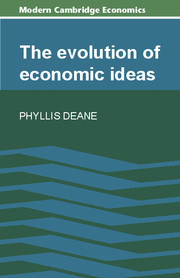Book contents
- Frontmatter
- Series preface
- Contents
- Introduction
- 1 Origins of modern economics
- 2 Adam Smith's theory of value
- 3 Origins of modern growth theory
- 4 Classical monetary theory
- 5 Ricardo on value, distribution and growth
- 6 Scope and methodology of classical political economy
- 7 The marginal revolution and the neo-classical triumph
- 8 The neo-classical theory of value
- 9 The Marxian alternative
- 10 Neo-classical orthodoxy in the inter-war period
- 11 Monetary theory in the neo-classical era
- 12 The Keynesian revolution
- 13 Twentieth-century growth theory
- 14 Methodological divisions in economics since Keynes
- Index of names
- Subject index
8 - The neo-classical theory of value
Published online by Cambridge University Press: 05 June 2012
- Frontmatter
- Series preface
- Contents
- Introduction
- 1 Origins of modern economics
- 2 Adam Smith's theory of value
- 3 Origins of modern growth theory
- 4 Classical monetary theory
- 5 Ricardo on value, distribution and growth
- 6 Scope and methodology of classical political economy
- 7 The marginal revolution and the neo-classical triumph
- 8 The neo-classical theory of value
- 9 The Marxian alternative
- 10 Neo-classical orthodoxy in the inter-war period
- 11 Monetary theory in the neo-classical era
- 12 The Keynesian revolution
- 13 Twentieth-century growth theory
- 14 Methodological divisions in economics since Keynes
- Index of names
- Subject index
Summary
As we have seen, Ricardo had been concerned by two shortfalls in his theory of value. The first was that a labour theory of value did not seem able to explain changes in value through time: for as soon as one admits the possibility of capital with differing degrees of durability (different lives that is) being involved in the production process, then a general rise in the share of wages could alter relative prices independently of relative labour inputs by raising the prices of labour-intensive products relative to capital intensive products. The second was that he had no answer to the question of what determined absolute value, for there was no commodity whose value was not dependent on its own costs of production: ‘that is, there is none which is not subject to require more or less labour for its production’. As far as the founders of the marginal revolution were concerned, Ricardo's problems in both of these respects were of his own making. His labour embodied theory of value had led English classical economics into a cul de sac from which there was no escape unless one were prepared to start from a new set of premises and with a new set of analytical tools.
- Type
- Chapter
- Information
- The Evolution of Economic Ideas , pp. 115 - 124Publisher: Cambridge University PressPrint publication year: 1978



